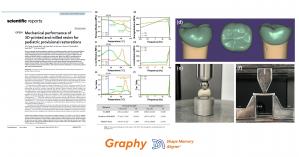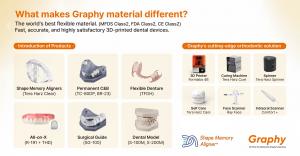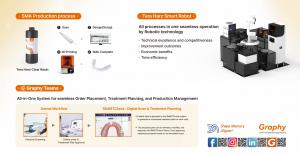Korean Researchers Publish Study on Pediatric 3D-Printed Dental Material in International Journal
– Graphy’s “TC-80” Resin Demonstrates Mechanical Stability Optimized for Adolescent Patients
TC-80 demonstrated favorable thermal stability and viscoelastic behavior under repeated functional load… suitable for pediatric patients with repeated stresses.”
MIAMI, FL, UNITED STATES, November 18, 2025 /EINPresswire.com/ -- Korean Researchers Publish Study on Pediatric 3D-Printed Dental Material in International Journal— the authors
– Graphy’s “TC-80” Resin Demonstrates Mechanical Stability Optimized for Adolescent Patients
A research team in South Korea has published scientific evidence confirming that the 3D-printed dental resin “TC-80”, developed by Graphy Inc., is suitable for long-term provisional restorations in pediatric and adolescent patients. The study was published in the international journal Scientific Reports (Nature Portfolio) and compared 3D printing and milling fabrication methods for pediatric dental materials. Results showed that TC-80 exhibited superior thermal stability, viscoelasticity, and mechanical endurance under repeated occlusal loading conditions.
The paper, titled “Mechanical performance of 3D-printed and milled resins for pediatric provisional restorations,” was co-corresponded by Prof. Je-Seon Song of Yonsei University and Dr. Hoon Kim, Principal Researcher at Graphy Inc. The study was conducted in collaboration with Prof. Yoo Seok Shin and Prof. Jee-Hwan Kim of Yonsei University.
The research team described TC-80 as “the optimal 3D-printed resin for growing patients.” In this study, three resins used for pediatric provisional restorations were compared: Graphy TC-80, a conventional C&B resin from company N, and a ceramic-based block from company V. TC-80 demonstrated superior performance across the following key properties.
First, Dynamic Mechanical Analysis (DMA) revealed that TC-80 maintained structural stability up to approximately 100°C, confirming high thermal resistance that preserves form even under high-temperature cleaning, sterilization, and dietary conditions. In contrast, competing materials exhibited rapid softening between 50–70°C.
In UV rheology tests, TC-80 demonstrated high storage modulus and viscosity exceeding 2,000 mPa·s, indicating a denser polymer network formation—interpreted as a factor contributing to its long-term durability and functional stability.
Furthermore, under repeated occlusal load conditions—one of the most critical parameters for dental restorative materials—TC-80 showed stable viscoelastic behavior. Pediatric patients experience frequent occlusal fluctuations and parafunctional stress in the range of 300–500 N, yet TC-80 maintained elastic recovery and structural integrity, confirming its potential for long-term clinical application.
In the paper, the authors stated:
“TC-80 demonstrated favorable thermal stability and viscoelastic behavior under repeated functional load… suitable for pediatric patients with repeated stresses.”
They concluded that TC-80’s ability to retain both thermal and mechanical stability under cyclic stress conditions makes it an excellent material choice for pediatric restorative applications.
The study also reaffirmed the advanced material technology behind Graphy’s proprietary resin platform. TC-80 was developed from Graphy’s urethane-acrylate-based oligomer, which shares the same material design technology as the company’s world-first Shape Memory Aligner (SMA) materials, TC-85 and TA-28.
Dr. Hoon Kim, Principal Researcher from Graphy Inc and co-corresponding author, commented, “TC-80 was designed to adapt to the dynamic occlusal environment of growing patients. It is not simply a stronger resin—it is a material that balances functional stability with biocompatibility. This publication demonstrates that Graphy’s material platform is achieving meaningful results across clinical, industrial, and academic fields.”
Building on this achievement, Graphy Inc. announced plans to expand its pediatric and adolescent dental material lineup, strengthen global certifications (FDA/KFDA), and continue the development of its 3D-printed medical device material platform for broader applications in digital dentistry and healthcare.
Paper Information: https://doi.org/10.1038/s41598-025-22841-2
Bob Lee
Graphy inc.
+ +1 888-616-2764
email us here
Visit us on social media:
LinkedIn
Instagram
Facebook
YouTube
About Graphy: Shaping the Future with Vision
Legal Disclaimer:
EIN Presswire provides this news content "as is" without warranty of any kind. We do not accept any responsibility or liability for the accuracy, content, images, videos, licenses, completeness, legality, or reliability of the information contained in this article. If you have any complaints or copyright issues related to this article, kindly contact the author above.



